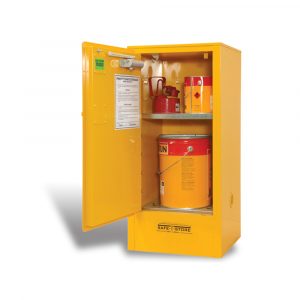
Hazardous Goods Storage

Hazardous goods such as flammable liquids or corrosive chemicals can pose a risk to people, property and the environment – even when they’re not in use. The good news is that risk can be reduced simply through awareness and by having the right protocols in place. Below we’ll cover off some of the main points regarding the safe storage of hazardous goods.
What are Hazardous Goods Storage Requirements?
The requirements for hazardous chemical storage are outlined in the Australian Standards. Whilst these standards are not law, they are recognised as an important part of a compliant solution. Each state government has their own Dangerous Goods Acts containing broad legal principles. In addition to these acts, the government has developed regulations and codes of practice to show businesses how to meet the requirements of the law.
To complement the broad acts set out above, Standards Australia have developed a series of standards to outline specific design requirements for hazardous goods storage.
Hazardous goods should be stored in Australian Standard compliant cabinets with adequate ventilation, spill containment capacity, dangerous goods signage and be constructed from appropriate materials. They will reduce risk and improve efficiencies in the handling of dangerous goods. It’s important to note that not all storage cabinets are the same – storage requirements differ based on the class of hazardous goods in line with Australian Standards.
Hazardous Goods Classes
There are 9 different classes of hazardous goods. Each of these classes have their own Australian Standards for safe storage to ensure they meet regulatory compliance. Each class differs in their level and type of risks, resulting in different storage requirements.
| Class | Dangerous Goods Type | Examples | Storage Cabinet |
| 1 | Explosives | Ammunitions, fireworks | |
| 2 | Gases | Oxygen, natural gas, aerosols | |
| 3 | Flammable Liquids | Solvents, paints, petrol, adhesives | |
| 4 | Flammable Solids | Sulphur, matches, alkali metals | |
| 5 | Oxidising Substances | Hydrogen peroxide, sodium nitrite, fertilisers | |
| 6 | Toxic & Infectious Substances | Lead compounds, clinical waste, pesticides | |
| 7 | Radioactive Material | Enriched uranium, radioactive ores, some medical equipment | |
| 8 | Corrosive Substances | Sulphuric acid, sodium hydroxide, battery fluid | |
| 9 | Miscellaneous Dangerous Substances & Articles | Zinc oxide, lithium ion batteries |
How to Store Different Hazardous Goods?
It is safe practice to avoid storing different classed hazardous goods together. In instances where different classes are stored separately, there should be adequate distance between hazardous goods to prevent the risk of fire or explosion, as well as gases and vapours.
What does this mean for my business?
Businesses could be held liable for accidents or injuries that result from using non-compliant storage. Under Workplace Health and Safety (WHS) regulations businesses have obligations to manage health and safety risks in the use, handling and storage of hazardous chemicals. Some of these obligations include:
- Ensuring these goods are correctly labelled.
- Identifying and eliminate potential safety risks.
- Implement and maintain control measures for the storage of the hazardous goods.
- Obtaining current Safety Data Sheets (SDS) from the manufacturer or supplier of the chemical.
- Providing fire protection, firefighting and safety equipment.
You can find more information about hazardous chemicals on the Safe Work Australia website. If you’d like more information about storage solutions to suit your particular application, contact Stratex on 1300 991 180 or email [email protected].









